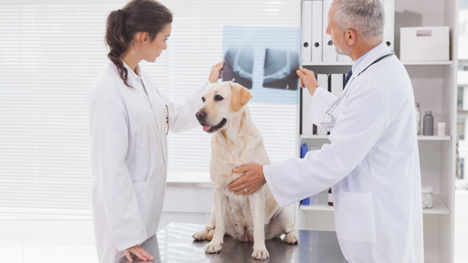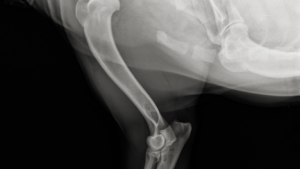How Much Is an X-ray for Dogs? Stomach, Chest & More

We give our dogs the best care possible. Despite all we do, sometimes they get hurt or sick or eat something they shouldn’t. When this happens, they may need an X-ray of their stomach, chest, or more. This article shares age-specific guidelines for dog X-rays, the average cost, and how your dog’s health and medical history could impact X-ray frequency.
Understanding Pet X-rays
X-rays are digital images of a dog’s bones, organs, and tissues. Vets order a pet X-ray when they want to
- Broken bones – If a pet is limping or is in pain, a vet will examine the area to check for broken bones. X-ray images can show the exact location and severity of a fracture.
- Blockage in the intestines – When dogs swallow something they shouldn’t, it may cause intestinal blockage. A stomach X-ray can reveal the object’s exact location.
- Bladder stones – Dogs get bladder, gallbladder, or kidney stones like humans. X-rays show their location and if they are causing blockages.
- Tumors – Not all tumors appear on an X-ray, but it’s a good first step to diagnose them because it’s less expensive than a CT scan.
- Dental problems – Most vets do a yearly dental X-ray to spot gum or teeth problems. Dogs are usually sedated during dental X-rays.
- Pregnancy- Vets X-ray a pregnant dog to check the puppies’ health. The images also determine how many puppies a female dog carries, their position, and whether the mother can safely deliver them through the birth canal.
- Hip problems – Hip dysplasia is diagnosed with an X-ray. These images help a vet decide the best treatment plan for a dog.
- Heart or lung problems – Vets do X-rays if a dog has breathing problems. X-rays can show if a dog has pneumonia, bronchitis, a fungal infection, or a mass.
How Often Should You Get an X-ray for Your Dog?
Age-Related X-rays
Vets use X-rays to check for a dog’s outstanding health problems, but they can also be used preventatively for a routine senior dog wellness check if necessary due to your dog’s specific health history or conditions.
Puppies
Pregnant dogs are X-rayed to determine the exact number of puppies she’s carrying, the size of the puppies, and their location. X-rays also tell the age of a puppy. A vet may recommend an X-ray if a puppy is a rescue dog and there’s a question about their age.
Young Adults
Adult dogs should receive dental X-rays yearly. A dog may have dental disease if it has broken or missing teeth, inflamed or swollen gums, or bad breath. An X-ray helps a vet understand the depth of the problem.
Senior Dogs
X-rays assess an older dog’s overall health. They detect early-stage cancers, tumors, heart or lung issues, hip or joint problems, or osteoporosis, which are common in senior dogs. A vet can diagnose arthritis in older dogs with an X-ray. The image shows swelling and any changes to a dog’s bones.
Breed-Specific Considerations
A dog’s breed determines how often a dog needs to be X-rayed during their lifetime. X-rays are good preventative measures, especially for certain breeds.
Large and Giant Breeds
Larger dog breeds are prone to elbow and hip dysplasia and other joint problems. They’re also prone to arthritis as they age. A vet may use X-rays as a preventative way for early diagnosis and treatment of these problems.
Small breeds
Displaced kneecaps are common for smaller breeds. X-rays help detect displacement and early treatment. Small breeds commonly affected with displaced kneecaps include
- Miniature poodles
- Chihuahuas
- Boston terriers
- Pomeranians
- Yorkshire terriers
Health Condition and History
A dog’s health condition or medical history impacts how often a dog needs X-rays. Certain chronic conditions require closer monitoring with regular X-rays and tests. Common ailments that require regular X-rays include a history of
- Hip dysplasia or joint problems- When a dog has hip or joint problems, regular X-rays are taken to monitor the progression of the problem.
- Dental concerns– When a dog has missing teeth, bad breath, or broken teeth, it may indicate dental disease. Yearly X-rays can diagnose and help vets treat the problem.
- Cancer- Once a dog is diagnosed, they’ll receive regular X-rays to monitor cancer.
- Tumors-Although some tumors are benign, vets will do regular X-rays to monitor them.

X-ray Frequency for Working and Sporting Dogs
Sport or working dogs get a lot of exercise and need regular monitoring. This may include X-rays to detect any early signs of musculoskeletal problems, including injuries or problems with
- Nerves
- Muscles
- Joints
- Tendons
- Cartilage
- Spinal disc
Recommendations from Veterinarians
Please discuss your dog’s health issues, breed, and medical history with your veterinarian to determine their eligibility for more frequent X-rays. They have the expertise and experience to guide you on how often a dog needs an X-ray.
Factors Affecting Pet X-ray Costs
Pet X-rays vary in cost depending on certain factors. Things that contribute to the cost of an X-ray include:
- whether a dog needs to be sedated
- how many views the vet must take
- the area of the body being X-rayed.
On average, a pet X-ray can cost $50 to $400. A dog’s size, breed, medical history, and medical problems affect the cost. Of course, emergencies such as a dog swallowing a foreign object will cost more than a routine screening X-ray.
Cost Breakdown of Pet X-rays
X-ray costs will vary depending on where you live and what type of X-ray your dog needs. These are the average cost breakdowns for pet X-rays.
| Type of X-ray or treatment before X-ray | Cost of X-ray |
| Sedation-Dog may need this to help calm them down to guarantee a clearer image | $50 to $220 |
| Chest X-ray-Looking for pneumonia, tumors, or asthma, | $150 to $250 |
| Stomach X-ray | $150 to $250 |
| Broken bone X-ray | $150mto $400 |
| Dental X-ray | $50 to $90 |
| Lung X-ray | $150 to $250 |
| Emergency X-rays | $200 to $400 |
Consultation fees will also add to the cost of X-ray costs.
What Is the Cost of a Dog Chest X-ray?
The average cost of a dog chest X-ray is $75 to $250, depending on where you live and the location being X-rayed.
Is a Normal Dog Stomach X-ray Different from an Abnormal One?
An abdominal X-ray includes looking at organs such as the
- Small and large Intestines
- Stomach
- Spleen
- Liver
- Diaphragm
How Much Does a Dog Leg X-ray Typically Cost?
The average dog leg X-ray costs $100 to $425, depending on the location and the need for sedation to keep the dog still for the imaging.
What Does a Normal Dog Lung X-ray Look Like?
A dog’s respiratory system includes the small and large airways and lungs. A dog breathes air through their nose and mouth. The air travels through their trachea into the right or left bronchi, then into smaller areas called bronchioles in their lungs. Small sacs called alveoli are at the end of the bronchioles. A dog’s respiratory system delivers oxygen into the blood throughout the body and removes carbon dioxide from the blood. Disease or infection can disrupt this oxygen flow and lead to serious illnesses.
How Can Pet Insurance Help?
Because X-rays and other medical costs can add up, pet insurance helps ease the burden of these costs. Odie Pet Insurance offsets the cost of injuries, illness, and preventative care for dogs.
Odie Pet Insurance covers X-rays in their comprehensive plan. If your pet needs a diagnostic X-ray, this portion of the cost or all of the costs may be covered, depending on your plan. One caveat is that Odie’s doesn’t cover pregnancy x-rays.
Pet insurance gives you control over your budget without being burdened by unexpected vet bills. Odie pet insurance makes your pet’s medical care manageable.
Because Odie’s pet insurance offers several dog plans, decide which fits your budget and your pet’s needs best. With this kind of flexibility, you can cover your dog’s X-rays.
What about the claims process for pet insurance?
When looking into pet insurance, understand the claims and payment process.
Reimbursement
This method is the most common for pet insurance companies. You pay out of pocket for the veterinarian bill, and then the insurance company reimburses you for what’s covered under the insurance plan. The steps look like this.
- You pay the vet bill after your dog’s visit.
- You fill out the pet insurance claim form.
- Submit the claim form and other required documentation to the insurer.
- After the claim is approved, you will be reimbursed for eligible expenses.
Odie’s Pet Insurance Plans
Illness & Injury Plan
This insurance plan is Odie’s most comprehensive plan covering illness and injuries your dog may incur. This plan covers
- Emergency vet visits
- Surgeries
- Overnight hospital stays
- X-rays
- Prescription meds
- Lab tests
- And much more
Accident-Only Plan
Odie’s Accident-Only Plan covers wounds, injuries, and vet treatments, including X-rays, Ultrasounds, tests, and emergency care your sweet pet might need if they accidentally get injured.
Wellness Plan
This add-on plan guarantees you can keep your dog up to date on their vaccinations, heartworm checks, and other routine checks.
Like humans, dogs sometimes get sick or injured. They may require an X-ray to determine the extent of damage or treatment needed. Pet X-ray costs depend on a dog’s health and medical history, the dog’s age, and the breed’s size. Where you live also affects how much a pet X-ray could cost you. If you have pet insurance, the financial burden of pet X-ray costs is lifted. You won’t be worried that you can’t pay your dog’s vet bills.
FAQs:
How Much Are Dog X-rays on Stomach?
On average, a dog X-ray of the stomach costs anywhere from $100 to $250 depending on the location that needs to be X-rayed, the area you live in, and if the dog needs sedation.
Are Dog X-rays Worth It?
Dog X-rays help diagnose problems and provide preventative care for your dog. They help your vet look at your dog’s internal organs to find foreign objects, broken bones, kidney stones, or dental problems.
Why Are X-rays So Expensive?
Here are the main reasons why X-rays are so expensive.
- Medical equipment is expensive- X-ray machines must be up to date to meet federal guidelines.
- Protective gear is expensive
- The Area of the dog’s body being X-rayed may need several prints
- Radiologist is expensive
- X-ray technician is expensive
- The cost of caring for the X-ray equipment is expensive.
The cost to sedate your dog before an X-ray may cost $50 to $220 depending on where you live, how big your dog is, vet costs, and if your dog has health issues that must be monitored.






